Case Study: Health Assessment of Lee Jones's Cardiovascular Health
VerifiedAdded on 2022/10/19
|7
|1565
|19
Case Study
AI Summary
This case study analyzes the health assessment of Lee Jones, focusing on his cardiovascular health. It begins with a comprehensive assessment, highlighting the importance of considering physical, psychological, social, and socioeconomic factors. The assessment reveals abnormal vital signs, including elevated blood pressure and blood glucose levels, alongside a high BMI, indicating potential hypertension and diabetes. The case study discusses Jones's medication, Metformin Hydrochloride and Captopril, explaining their uses, side effects, and precautions. It then delves into lifestyle factors, emphasizing the impact of a sedentary work life, reliance on take-away food, and lack of exercise on his condition. The analysis connects these factors to the exacerbation of hypertension and diabetes, stressing the need for lifestyle modifications in his long-term treatment plan. References to relevant research are provided to support the analysis.
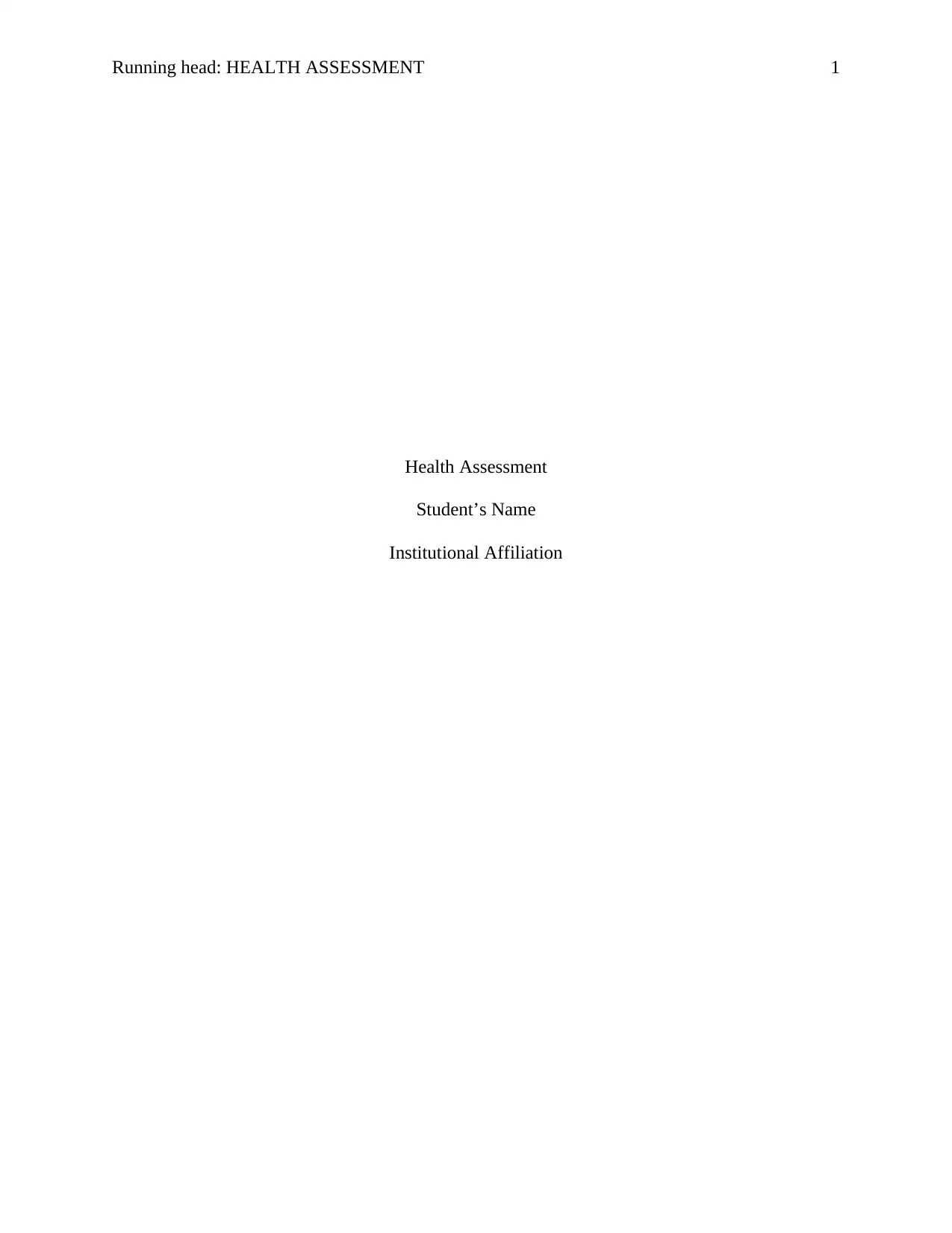
Running head: HEALTH ASSESSMENT 1
Health Assessment
Student’s Name
Institutional Affiliation
Health Assessment
Student’s Name
Institutional Affiliation
Paraphrase This Document
Need a fresh take? Get an instant paraphrase of this document with our AI Paraphraser
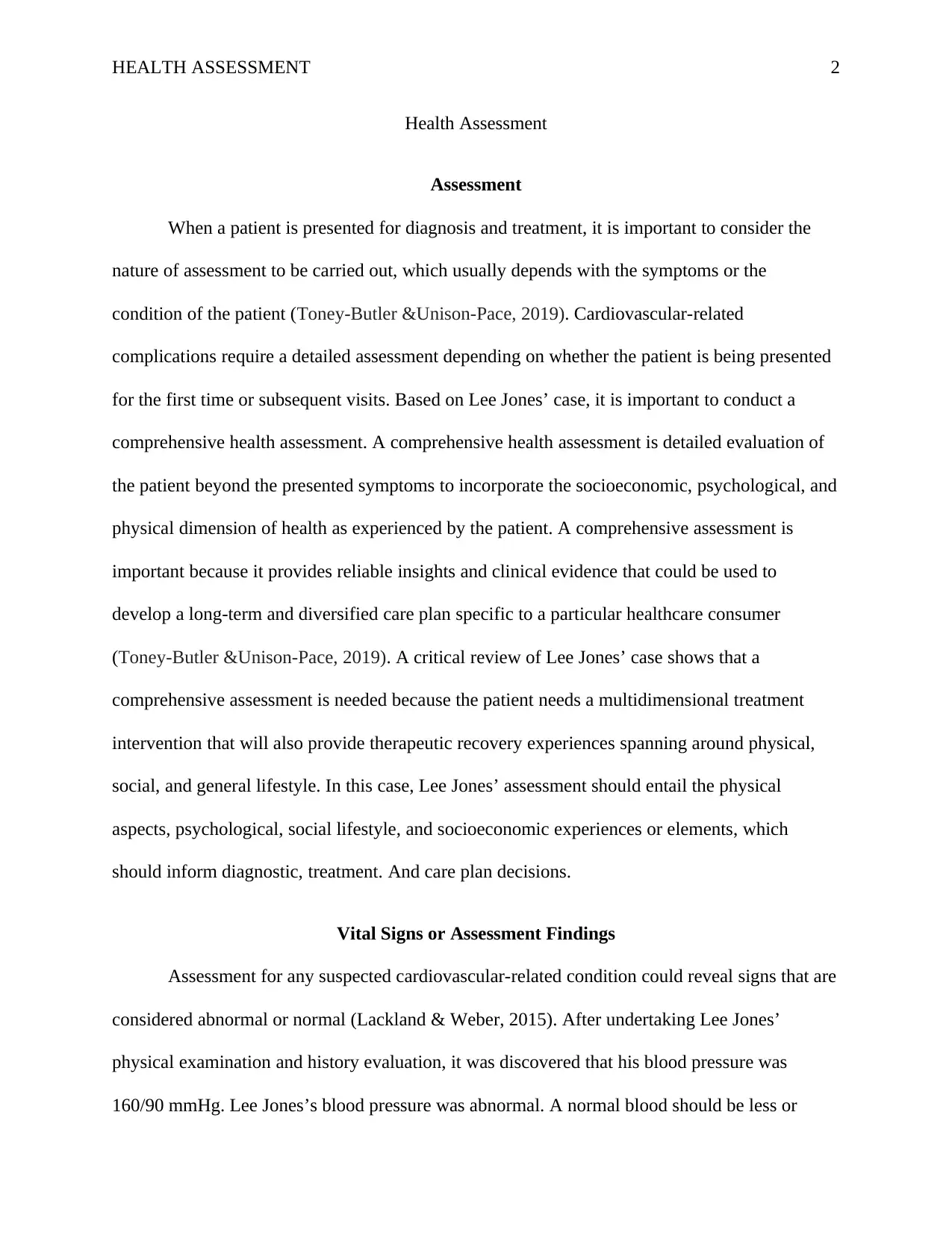
HEALTH ASSESSMENT 2
Health Assessment
Assessment
When a patient is presented for diagnosis and treatment, it is important to consider the
nature of assessment to be carried out, which usually depends with the symptoms or the
condition of the patient (Toney-Butler &Unison-Pace, 2019). Cardiovascular-related
complications require a detailed assessment depending on whether the patient is being presented
for the first time or subsequent visits. Based on Lee Jones’ case, it is important to conduct a
comprehensive health assessment. A comprehensive health assessment is detailed evaluation of
the patient beyond the presented symptoms to incorporate the socioeconomic, psychological, and
physical dimension of health as experienced by the patient. A comprehensive assessment is
important because it provides reliable insights and clinical evidence that could be used to
develop a long-term and diversified care plan specific to a particular healthcare consumer
(Toney-Butler &Unison-Pace, 2019). A critical review of Lee Jones’ case shows that a
comprehensive assessment is needed because the patient needs a multidimensional treatment
intervention that will also provide therapeutic recovery experiences spanning around physical,
social, and general lifestyle. In this case, Lee Jones’ assessment should entail the physical
aspects, psychological, social lifestyle, and socioeconomic experiences or elements, which
should inform diagnostic, treatment. And care plan decisions.
Vital Signs or Assessment Findings
Assessment for any suspected cardiovascular-related condition could reveal signs that are
considered abnormal or normal (Lackland & Weber, 2015). After undertaking Lee Jones’
physical examination and history evaluation, it was discovered that his blood pressure was
160/90 mmHg. Lee Jones’s blood pressure was abnormal. A normal blood should be less or
Health Assessment
Assessment
When a patient is presented for diagnosis and treatment, it is important to consider the
nature of assessment to be carried out, which usually depends with the symptoms or the
condition of the patient (Toney-Butler &Unison-Pace, 2019). Cardiovascular-related
complications require a detailed assessment depending on whether the patient is being presented
for the first time or subsequent visits. Based on Lee Jones’ case, it is important to conduct a
comprehensive health assessment. A comprehensive health assessment is detailed evaluation of
the patient beyond the presented symptoms to incorporate the socioeconomic, psychological, and
physical dimension of health as experienced by the patient. A comprehensive assessment is
important because it provides reliable insights and clinical evidence that could be used to
develop a long-term and diversified care plan specific to a particular healthcare consumer
(Toney-Butler &Unison-Pace, 2019). A critical review of Lee Jones’ case shows that a
comprehensive assessment is needed because the patient needs a multidimensional treatment
intervention that will also provide therapeutic recovery experiences spanning around physical,
social, and general lifestyle. In this case, Lee Jones’ assessment should entail the physical
aspects, psychological, social lifestyle, and socioeconomic experiences or elements, which
should inform diagnostic, treatment. And care plan decisions.
Vital Signs or Assessment Findings
Assessment for any suspected cardiovascular-related condition could reveal signs that are
considered abnormal or normal (Lackland & Weber, 2015). After undertaking Lee Jones’
physical examination and history evaluation, it was discovered that his blood pressure was
160/90 mmHg. Lee Jones’s blood pressure was abnormal. A normal blood should be less or
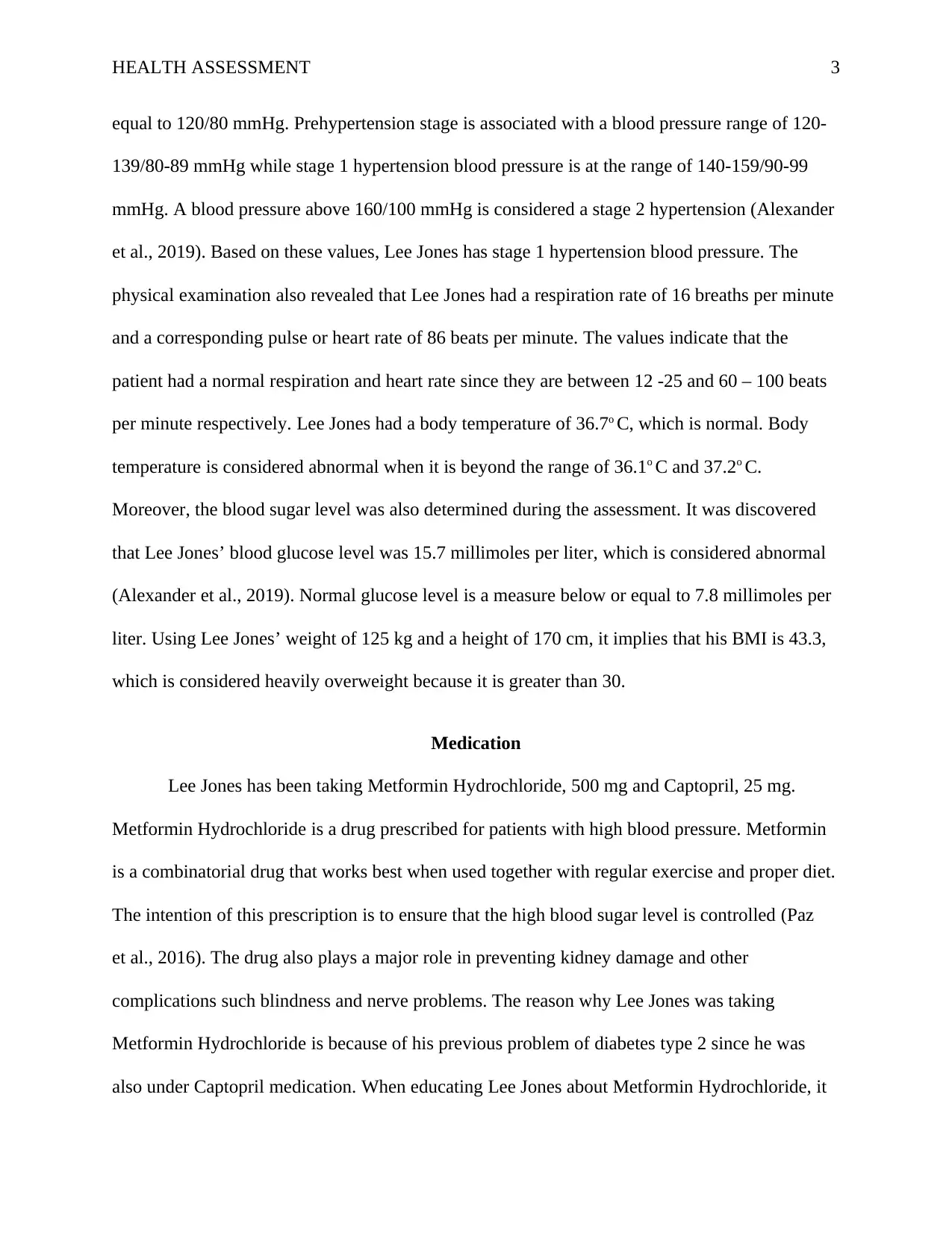
HEALTH ASSESSMENT 3
equal to 120/80 mmHg. Prehypertension stage is associated with a blood pressure range of 120-
139/80-89 mmHg while stage 1 hypertension blood pressure is at the range of 140-159/90-99
mmHg. A blood pressure above 160/100 mmHg is considered a stage 2 hypertension (Alexander
et al., 2019). Based on these values, Lee Jones has stage 1 hypertension blood pressure. The
physical examination also revealed that Lee Jones had a respiration rate of 16 breaths per minute
and a corresponding pulse or heart rate of 86 beats per minute. The values indicate that the
patient had a normal respiration and heart rate since they are between 12 -25 and 60 – 100 beats
per minute respectively. Lee Jones had a body temperature of 36.7o C, which is normal. Body
temperature is considered abnormal when it is beyond the range of 36.1o C and 37.2o C.
Moreover, the blood sugar level was also determined during the assessment. It was discovered
that Lee Jones’ blood glucose level was 15.7 millimoles per liter, which is considered abnormal
(Alexander et al., 2019). Normal glucose level is a measure below or equal to 7.8 millimoles per
liter. Using Lee Jones’ weight of 125 kg and a height of 170 cm, it implies that his BMI is 43.3,
which is considered heavily overweight because it is greater than 30.
Medication
Lee Jones has been taking Metformin Hydrochloride, 500 mg and Captopril, 25 mg.
Metformin Hydrochloride is a drug prescribed for patients with high blood pressure. Metformin
is a combinatorial drug that works best when used together with regular exercise and proper diet.
The intention of this prescription is to ensure that the high blood sugar level is controlled (Paz
et al., 2016). The drug also plays a major role in preventing kidney damage and other
complications such blindness and nerve problems. The reason why Lee Jones was taking
Metformin Hydrochloride is because of his previous problem of diabetes type 2 since he was
also under Captopril medication. When educating Lee Jones about Metformin Hydrochloride, it
equal to 120/80 mmHg. Prehypertension stage is associated with a blood pressure range of 120-
139/80-89 mmHg while stage 1 hypertension blood pressure is at the range of 140-159/90-99
mmHg. A blood pressure above 160/100 mmHg is considered a stage 2 hypertension (Alexander
et al., 2019). Based on these values, Lee Jones has stage 1 hypertension blood pressure. The
physical examination also revealed that Lee Jones had a respiration rate of 16 breaths per minute
and a corresponding pulse or heart rate of 86 beats per minute. The values indicate that the
patient had a normal respiration and heart rate since they are between 12 -25 and 60 – 100 beats
per minute respectively. Lee Jones had a body temperature of 36.7o C, which is normal. Body
temperature is considered abnormal when it is beyond the range of 36.1o C and 37.2o C.
Moreover, the blood sugar level was also determined during the assessment. It was discovered
that Lee Jones’ blood glucose level was 15.7 millimoles per liter, which is considered abnormal
(Alexander et al., 2019). Normal glucose level is a measure below or equal to 7.8 millimoles per
liter. Using Lee Jones’ weight of 125 kg and a height of 170 cm, it implies that his BMI is 43.3,
which is considered heavily overweight because it is greater than 30.
Medication
Lee Jones has been taking Metformin Hydrochloride, 500 mg and Captopril, 25 mg.
Metformin Hydrochloride is a drug prescribed for patients with high blood pressure. Metformin
is a combinatorial drug that works best when used together with regular exercise and proper diet.
The intention of this prescription is to ensure that the high blood sugar level is controlled (Paz
et al., 2016). The drug also plays a major role in preventing kidney damage and other
complications such blindness and nerve problems. The reason why Lee Jones was taking
Metformin Hydrochloride is because of his previous problem of diabetes type 2 since he was
also under Captopril medication. When educating Lee Jones about Metformin Hydrochloride, it
⊘ This is a preview!⊘
Do you want full access?
Subscribe today to unlock all pages.

Trusted by 1+ million students worldwide
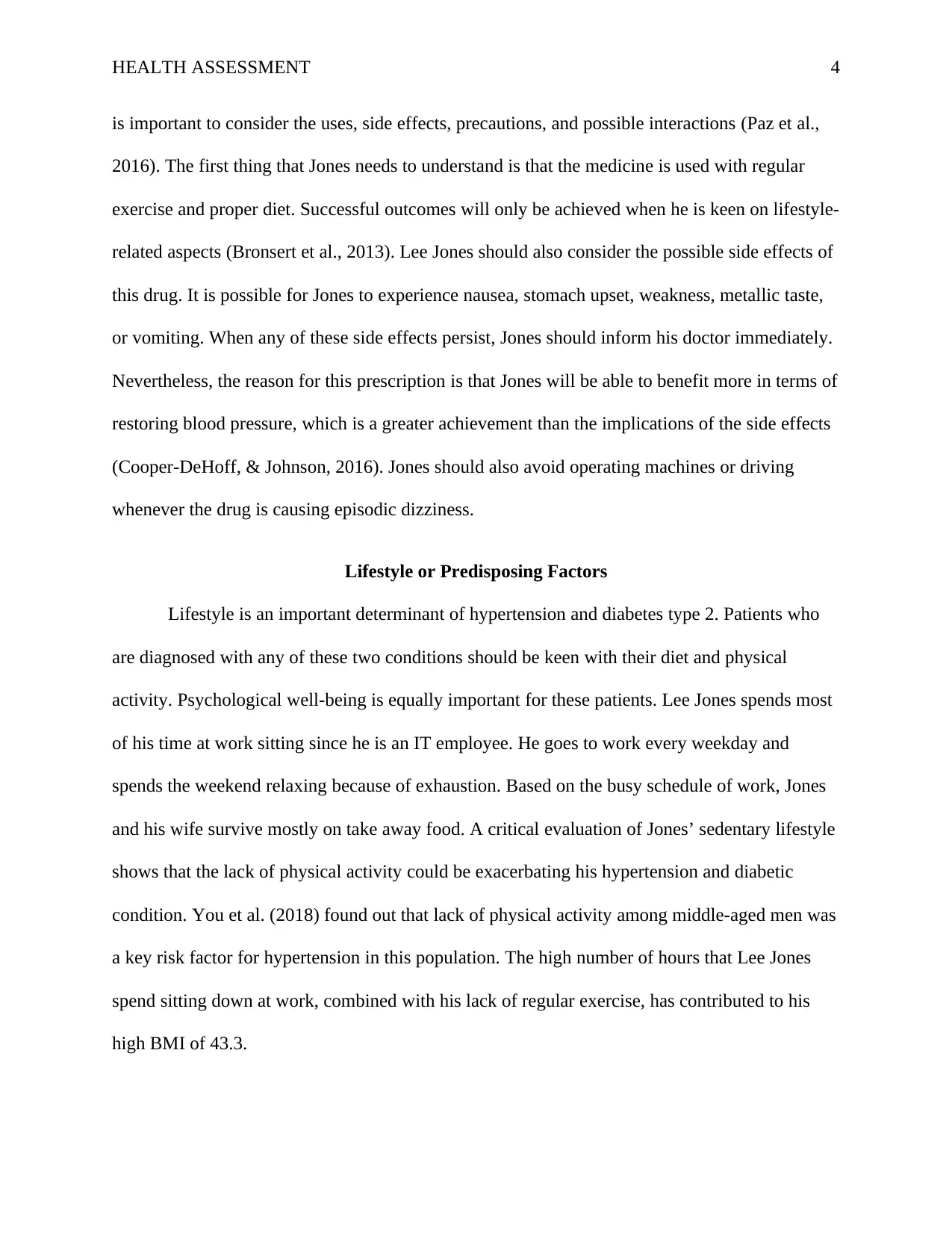
HEALTH ASSESSMENT 4
is important to consider the uses, side effects, precautions, and possible interactions (Paz et al.,
2016). The first thing that Jones needs to understand is that the medicine is used with regular
exercise and proper diet. Successful outcomes will only be achieved when he is keen on lifestyle-
related aspects (Bronsert et al., 2013). Lee Jones should also consider the possible side effects of
this drug. It is possible for Jones to experience nausea, stomach upset, weakness, metallic taste,
or vomiting. When any of these side effects persist, Jones should inform his doctor immediately.
Nevertheless, the reason for this prescription is that Jones will be able to benefit more in terms of
restoring blood pressure, which is a greater achievement than the implications of the side effects
(Cooper-DeHoff, & Johnson, 2016). Jones should also avoid operating machines or driving
whenever the drug is causing episodic dizziness.
Lifestyle or Predisposing Factors
Lifestyle is an important determinant of hypertension and diabetes type 2. Patients who
are diagnosed with any of these two conditions should be keen with their diet and physical
activity. Psychological well-being is equally important for these patients. Lee Jones spends most
of his time at work sitting since he is an IT employee. He goes to work every weekday and
spends the weekend relaxing because of exhaustion. Based on the busy schedule of work, Jones
and his wife survive mostly on take away food. A critical evaluation of Jones’ sedentary lifestyle
shows that the lack of physical activity could be exacerbating his hypertension and diabetic
condition. You et al. (2018) found out that lack of physical activity among middle-aged men was
a key risk factor for hypertension in this population. The high number of hours that Lee Jones
spend sitting down at work, combined with his lack of regular exercise, has contributed to his
high BMI of 43.3.
is important to consider the uses, side effects, precautions, and possible interactions (Paz et al.,
2016). The first thing that Jones needs to understand is that the medicine is used with regular
exercise and proper diet. Successful outcomes will only be achieved when he is keen on lifestyle-
related aspects (Bronsert et al., 2013). Lee Jones should also consider the possible side effects of
this drug. It is possible for Jones to experience nausea, stomach upset, weakness, metallic taste,
or vomiting. When any of these side effects persist, Jones should inform his doctor immediately.
Nevertheless, the reason for this prescription is that Jones will be able to benefit more in terms of
restoring blood pressure, which is a greater achievement than the implications of the side effects
(Cooper-DeHoff, & Johnson, 2016). Jones should also avoid operating machines or driving
whenever the drug is causing episodic dizziness.
Lifestyle or Predisposing Factors
Lifestyle is an important determinant of hypertension and diabetes type 2. Patients who
are diagnosed with any of these two conditions should be keen with their diet and physical
activity. Psychological well-being is equally important for these patients. Lee Jones spends most
of his time at work sitting since he is an IT employee. He goes to work every weekday and
spends the weekend relaxing because of exhaustion. Based on the busy schedule of work, Jones
and his wife survive mostly on take away food. A critical evaluation of Jones’ sedentary lifestyle
shows that the lack of physical activity could be exacerbating his hypertension and diabetic
condition. You et al. (2018) found out that lack of physical activity among middle-aged men was
a key risk factor for hypertension in this population. The high number of hours that Lee Jones
spend sitting down at work, combined with his lack of regular exercise, has contributed to his
high BMI of 43.3.
Paraphrase This Document
Need a fresh take? Get an instant paraphrase of this document with our AI Paraphraser
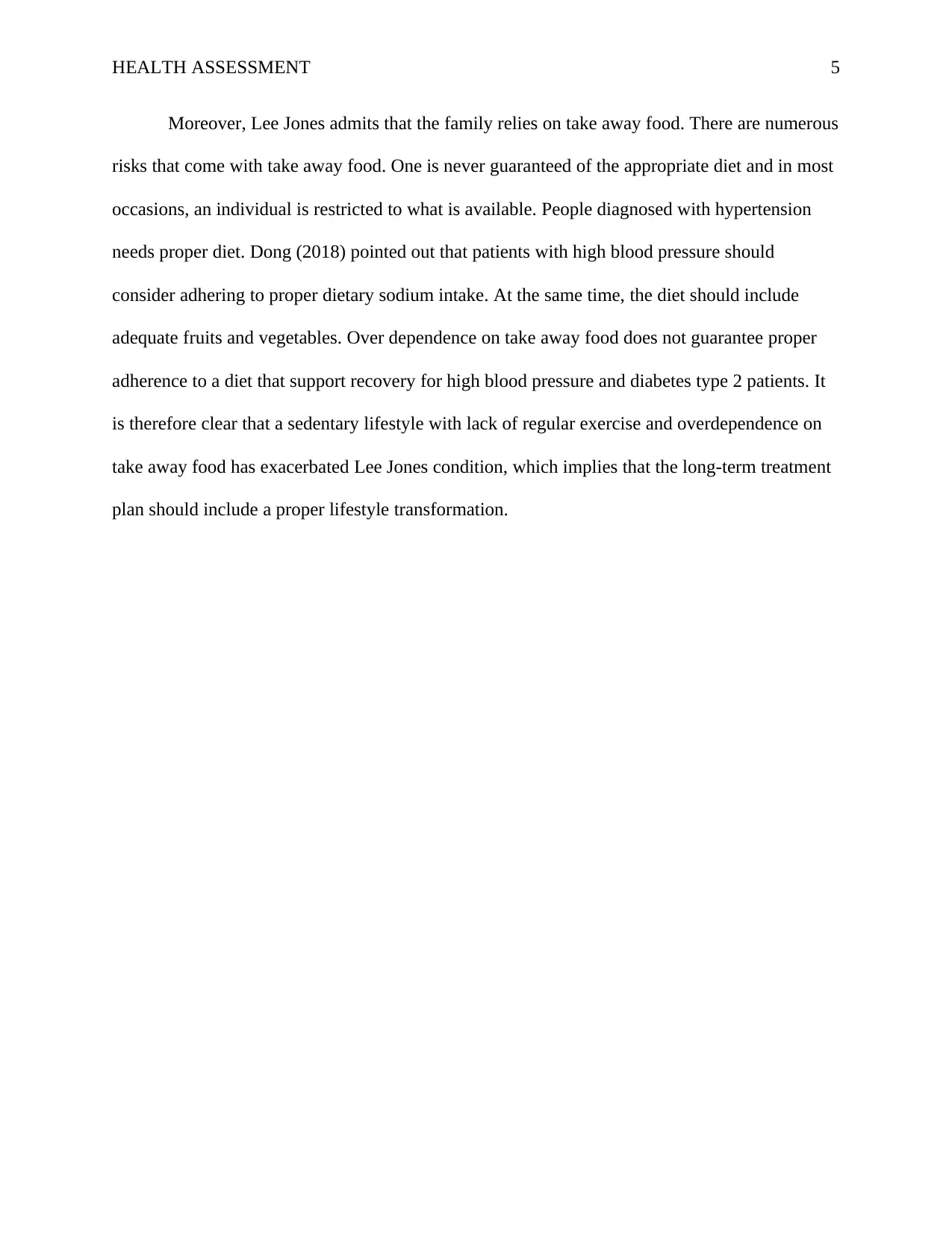
HEALTH ASSESSMENT 5
Moreover, Lee Jones admits that the family relies on take away food. There are numerous
risks that come with take away food. One is never guaranteed of the appropriate diet and in most
occasions, an individual is restricted to what is available. People diagnosed with hypertension
needs proper diet. Dong (2018) pointed out that patients with high blood pressure should
consider adhering to proper dietary sodium intake. At the same time, the diet should include
adequate fruits and vegetables. Over dependence on take away food does not guarantee proper
adherence to a diet that support recovery for high blood pressure and diabetes type 2 patients. It
is therefore clear that a sedentary lifestyle with lack of regular exercise and overdependence on
take away food has exacerbated Lee Jones condition, which implies that the long-term treatment
plan should include a proper lifestyle transformation.
Moreover, Lee Jones admits that the family relies on take away food. There are numerous
risks that come with take away food. One is never guaranteed of the appropriate diet and in most
occasions, an individual is restricted to what is available. People diagnosed with hypertension
needs proper diet. Dong (2018) pointed out that patients with high blood pressure should
consider adhering to proper dietary sodium intake. At the same time, the diet should include
adequate fruits and vegetables. Over dependence on take away food does not guarantee proper
adherence to a diet that support recovery for high blood pressure and diabetes type 2 patients. It
is therefore clear that a sedentary lifestyle with lack of regular exercise and overdependence on
take away food has exacerbated Lee Jones condition, which implies that the long-term treatment
plan should include a proper lifestyle transformation.
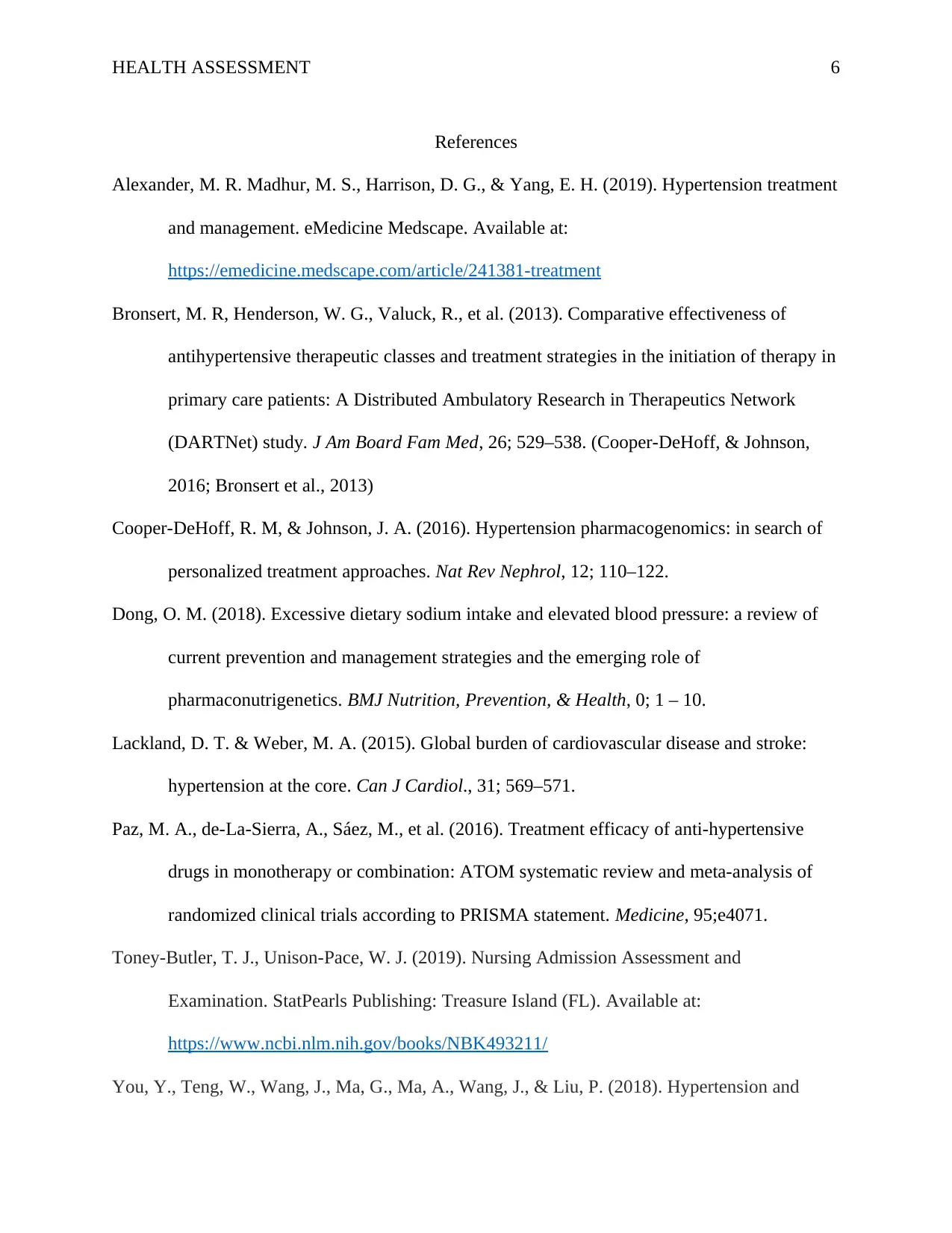
HEALTH ASSESSMENT 6
References
Alexander, M. R. Madhur, M. S., Harrison, D. G., & Yang, E. H. (2019). Hypertension treatment
and management. eMedicine Medscape. Available at:
https://emedicine.medscape.com/article/241381-treatment
Bronsert, M. R, Henderson, W. G., Valuck, R., et al. (2013). Comparative effectiveness of
antihypertensive therapeutic classes and treatment strategies in the initiation of therapy in
primary care patients: A Distributed Ambulatory Research in Therapeutics Network
(DARTNet) study. J Am Board Fam Med, 26; 529–538. (Cooper-DeHoff, & Johnson,
2016; Bronsert et al., 2013)
Cooper-DeHoff, R. M, & Johnson, J. A. (2016). Hypertension pharmacogenomics: in search of
personalized treatment approaches. Nat Rev Nephrol, 12; 110–122.
Dong, O. M. (2018). Excessive dietary sodium intake and elevated blood pressure: a review of
current prevention and management strategies and the emerging role of
pharmaconutrigenetics. BMJ Nutrition, Prevention, & Health, 0; 1 – 10.
Lackland, D. T. & Weber, M. A. (2015). Global burden of cardiovascular disease and stroke:
hypertension at the core. Can J Cardiol., 31; 569–571.
Paz, M. A., de-La-Sierra, A., Sáez, M., et al. (2016). Treatment efficacy of anti-hypertensive
drugs in monotherapy or combination: ATOM systematic review and meta-analysis of
randomized clinical trials according to PRISMA statement. Medicine, 95;e4071.
Toney-Butler, T. J., Unison-Pace, W. J. (2019). Nursing Admission Assessment and
Examination. StatPearls Publishing: Treasure Island (FL). Available at:
https://www.ncbi.nlm.nih.gov/books/NBK493211/
You, Y., Teng, W., Wang, J., Ma, G., Ma, A., Wang, J., & Liu, P. (2018). Hypertension and
References
Alexander, M. R. Madhur, M. S., Harrison, D. G., & Yang, E. H. (2019). Hypertension treatment
and management. eMedicine Medscape. Available at:
https://emedicine.medscape.com/article/241381-treatment
Bronsert, M. R, Henderson, W. G., Valuck, R., et al. (2013). Comparative effectiveness of
antihypertensive therapeutic classes and treatment strategies in the initiation of therapy in
primary care patients: A Distributed Ambulatory Research in Therapeutics Network
(DARTNet) study. J Am Board Fam Med, 26; 529–538. (Cooper-DeHoff, & Johnson,
2016; Bronsert et al., 2013)
Cooper-DeHoff, R. M, & Johnson, J. A. (2016). Hypertension pharmacogenomics: in search of
personalized treatment approaches. Nat Rev Nephrol, 12; 110–122.
Dong, O. M. (2018). Excessive dietary sodium intake and elevated blood pressure: a review of
current prevention and management strategies and the emerging role of
pharmaconutrigenetics. BMJ Nutrition, Prevention, & Health, 0; 1 – 10.
Lackland, D. T. & Weber, M. A. (2015). Global burden of cardiovascular disease and stroke:
hypertension at the core. Can J Cardiol., 31; 569–571.
Paz, M. A., de-La-Sierra, A., Sáez, M., et al. (2016). Treatment efficacy of anti-hypertensive
drugs in monotherapy or combination: ATOM systematic review and meta-analysis of
randomized clinical trials according to PRISMA statement. Medicine, 95;e4071.
Toney-Butler, T. J., Unison-Pace, W. J. (2019). Nursing Admission Assessment and
Examination. StatPearls Publishing: Treasure Island (FL). Available at:
https://www.ncbi.nlm.nih.gov/books/NBK493211/
You, Y., Teng, W., Wang, J., Ma, G., Ma, A., Wang, J., & Liu, P. (2018). Hypertension and
⊘ This is a preview!⊘
Do you want full access?
Subscribe today to unlock all pages.

Trusted by 1+ million students worldwide

HEALTH ASSESSMENT 7
physical activity in middle-aged and older adults in China. Scientific reports, 8(1); 16098.
physical activity in middle-aged and older adults in China. Scientific reports, 8(1); 16098.
1 out of 7
Related Documents
Your All-in-One AI-Powered Toolkit for Academic Success.
+13062052269
info@desklib.com
Available 24*7 on WhatsApp / Email
![[object Object]](/_next/static/media/star-bottom.7253800d.svg)
Unlock your academic potential
Copyright © 2020–2025 A2Z Services. All Rights Reserved. Developed and managed by ZUCOL.





